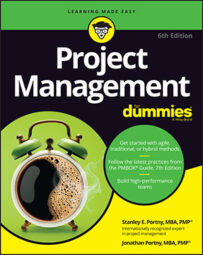Creating and continually reinforcing a team identity
Committing to work with others to achieve a common goal encourages people to overcome problems they may encounter along the way. The following tips can help clarify your team’s purpose and encourage team members to support one another as you work together to achieve it:- Clarify team vision and working relationships. As soon as you have a team, work with the team members to develop a project mission that members can understand and support. Give people an opportunity to become familiar with each other’s work style.
- Define team procedures. Encourage your team to develop its own work procedures instead of allowing people to use the approaches of their respective functional groups.
- Clearly define each team member’s roles and responsibilities on the project tasks he’ll be performing. You also should include any authority that team members can use in the performance of their assigned tasks.
- Clarify each person’s authority. Team members may have to represent their functional areas when making project decisions. Clarify each team member’s level of independent authority to make such decisions and determine who outside the team can make any decisions that are beyond the purview of the team member.
- Be aware of and attend to your team’s functioning. Help people establish comfortable and productive interpersonal relationships. Continue to support these relationships throughout your project.
- Reinforce the overall project goals and the dependence of team members on one another. As the project manager, you must continually remind team members of the overarching project goals and focus their attention on how they influence and affect each other’s work.
Getting team-member commitment
Team members typically have little or no authority over each other in a matrix environment. Therefore, they perform their project assignments because they choose to, not because they have to. Work with people initially and throughout your project to encourage them to commit to your project’s goals.Eliciting support from other people in the environment
The project manager’s authority over team members is frequently limited; for the most part, you must rely on suggestion, encouragement, and persuasion to help team members address issues and accomplish their assignments. Therefore, you have to identify and establish relationships with others who can help you deal with situations that you’re unable to resolve yourself. Here’s how:- Get a champion. Because you most likely don’t have authority over all the people who affect the chances for your project’s success, get an ally who does have that authority — and do so as soon as possible. This project champion can help resolve team members’ schedule and interpersonal conflicts and raise your project’s visibility in the organization.
- Ask for and acknowledge the support of your team members’ functional managers. By thanking functional managers for supporting their staff and allowing the staff to honor their project commitments, you’re encouraging those managers to provide similar support for you and others in the future.
- Work closely with your project’s executive sponsor. Make sure you know the role and responsibilities of the project executive sponsor.
Heading off common problems before they arise
Take the following steps upfront and throughout your project to head off potential conflicts and concerns before they materialize:- Plan in sufficient detail. Work with team members to clearly and concisely define the project work and each person’s specific roles and responsibilities for all activities. This planning helps people more accurately estimate the amount of effort they need to give and the timing of that effort for each assignment.
- Identify and address conflicts promptly. Conflicts frequently arise in a matrix environment, given people’s diverse responsibilities, different styles, and lack of experience working together. Encourage people to identify and discuss conflicts as soon as they occur. Develop systems and procedures to deal with conflicts promptly — before they get out of hand.
- Encourage open communication among team members, especially regarding problems and frustrations. The earlier you hear about problems, the more time you have to deal with them. Discussing and resolving team issues encourages working relationships that are more enjoyable and productive.
- Encourage upper management to establish an oversight committee to monitor project performance and to address resource and other conflicts. Project and functional managers must focus on the goals for their respective areas of responsibility. Often, both groups rely on the same pool of people to reach these goals. But these diverse needs can place conflicting demands on people’s time and effort. An upper-management oversight committee can ensure that the needs of the entire organization are considered when addressing these conflicts.

